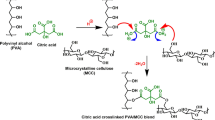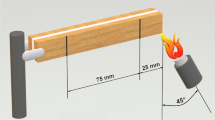Abstract
Suspensions of commercial refined beech pulp (RBP) were further processed through mechanical disintegration (MD-RBP), chemical modification (CM-RBP) and through chemical modification followed by mechanical disintegration (CM-MD-RBP). Nanocomposites were prepared by compounding a poly(vinyl acetate) (PVAc) latex adhesive with increasing contents of the different types of nanofibrils, and the resulting nanocomposites were analyzed by dynamic mechanical analysis (DMA). Also, the suitability of using the CM-RBP fibrils to formulate PVAc adhesives for wood bonded assemblies with improved heat resistance was studied. The presence of cellulose nanofibrils had a strong influence on the viscoelastic properties of PVAc latex films. For all nanocomposites, increasing amounts of cellulose nanofibrils (treated or untreated) led to increasing reinforcing effects in the glassy state, but especially in the PVAc and PVOH glass transitions. This reinforcement primarily resulted from interactions between the cellulose fibrils network and the hydrophilic PVOH matrix that led to the complete disappearance of the PVOH glass transition (tan δ peak) for some fibril types and contents. At any given concentration in the PVOH transition, the CM-MD-RBP nanofibrils provided the highest reinforcement, followed by the MD-RBP, CM-RBP and the untreated RBP. Finally, the use of the CM-RBP fibrils to prepare PVAc reinforced adhesives for wood bonding was promising since, even though they generally performed worse in dry and wet conditions, the boards showed superior heat resistance (EN 14257) and passed the test for durability class D1.




Similar content being viewed by others
References
Alemdar A, Sain M (2008) Biocomposites from wheat straw nanofibers: morphology, thermal and mechanical properties. Compos Sci Technol 68(2):557–565
Andresen M, Johansson LS, Tanem BS, Stenius P (2006) Properties and characterization of hydrophobized microfibrillated cellulose. Cellulose 13:665–677
Araki J, Wada M, Kuga S (2001) Steric stabilization of a cellulose microcrystal suspension by poly(ethylene glycol) grafting. Langmuir 17:21–27
Azizi Samir MAS, Alloin F, Dufresne A (2005) Review of recent research into cellulosic whiskers, their properties and their application in nanocomposite field. Biomacromolecules 6:612–626
Backman AC, Lindberg KAH (2004) Interaction between wood and polyvinyl acetate glue studied with dynamic mechanical analysis and scanning electron microscopy. J Appl Polym Sci 91:3009–3015
Bordeanu N, Eyholzer C, Zimmermann T (2008) Cellulose nanostructures with tailored functionalities. Pending patent
Cantiani R, Guerin G, Senechal A, Vincent I, Benchimol J (2001a) Supplementation of cellulose nanofibrils with carboxycellulose with low degree of substitution. US patent 6231657
Cantiani R, Guerin G, Senechal A, Vincent I, Benchimol J (2001b) Additivation of essentially amorphous cellulose nanofibrils with carboxyl cellulose with a high degree of substitution. US patent 6224663
Cantiani R, Guerin G, Senechal A, Vincent I, Benchimol J (2001c) Supplementation of essentially amorphous cellulose nanofibrils with carboxycellulose which has a high degree of substitution. US patent 6306207
Cash MJ, Chan AN, Conner HT, Cowan PJ, Gelman RA, Lusvardi KM, Thompson SA, Tise FP (2000) Derivatized microfibrillar polysaccharide. WO patent 0047628
Chakraborty A, Sain M, Kortschot M (2006) Reinforcing potential of wood pulp-derived microfibres in a PVA matrix. Holzforschung 60:53–58
Couderc S, Ducloux O, Kim BJ, Someya T (2009) A mechanical switch device made of a polyimide-coated microfibrillated cellulose sheet. J Micromech Microeng 19:055006
Dalmas F, Cavaillé JY, Gauthier C, Chazeau L, Dendievel R (2007) Viscoelastic behaviour and electrical properties of flexible nanofiber filled polymer nanocomposites. Influence of procesing conditions. Comp Sci Technol 67:829–839
De Rodriguez NLG, Thielemans W, Dufresne A (2006) Sisal cellulose whiskers reinforced polyvinyl acetate nanocomposites. Cellulose 13(3):261–270
Dinand E, Chanzy H, Vignon MR, Maureaux A, Vincent I (1996) Microfibrillated cellulose and method for preparing same from primary wall plant pulp, particularly sugar beet pulp. WO patent 9624720
European Standard EN 14257:2006 Adhesives—wood adhesives—determination of tensile strength of lap joints at elevated temperature (WATT’91)
European Standard EN 204:2001 Classification of thermoplastic wood adhesives for non-structural applications
European Standard EN 205:2003 Adhesives—wood adhesives for non-structural applications—determination of tensile shear strength of lap joints
Excoffier G, Vignon M, Benchimol J, Vincent I, Hannuskela T, Chauve V (1999) Parenchyma cellulose substituted with carboxyalkyl groups and preparation method. WO patent 9938892
Eyholzer C, Bordeanu N, Lopez-Suevos F, Rentsch D, Zimmermann T, Oksman K (2009) Preparation and characterization of water-redispersible nanofibrillated cellulose in powder form. Cellulose, under final revision
Eyler RW, Klug ED, Diephuis F (1947) Determination of degree of substitution of sodium carboxymethylcellulose. Anal Chem 19(1):24–27
Goussé C, Chanzy H, Cerrada ML, Fleury E (2004) Surface silylation of cellulose microfibrils: preparation and rheological properties. Polymer 45:1569–1575
Herrick FW (1984) Process for preparing microfibrillated cellulose. US patent 4481077
Hubbe MA, Rojas OJ, Lucia LA, Sain M (2008) Cellulosic nanocomposites: a review. BioRes 3(3):929–980
Hult EL, Larsson PT, Iversen T (2001) Cellulose fibril aggregation—an inherent property of kraft pulps. Polymer 42:3309–3314
Iwamoto S, Nakagaito AN, Yano H (2007) Nano-fibrillation of pulp fibers for the processing of transparent nanocomposites. Appl Phys A: Mater Sci Process 89(2):461–466
Kristo E, Biliaderis CG (2007) Physical properties of starch nanocrystal-reinforced pullulan films. Carbohyd Polym 68:146–158
Kvien K, Oksman K (2007) Orientiation of cellulose nanowhiskers in polyvinyl alcohol. Appl Phys A 87:641–643
Laivins GV, Scallan AM (1993) The mechanism of hornification of wood pulps. In: Baker CF (ed) Products of papermaking. Trans. 10th fundamental research symposium. Pira International, Oxford, pp 1235–1260
Lasseuguette E (2008) Grafting onto microfibrils of native cellulose. Cellulose 15:571–580
Lindström T, Carlsson G (1982) The effect of carboxyl groups and their ionic form during drying on the hornification of cellulose fibers. Svensk Papperstidn 85(15):R146–R151
López-Suevos F, Frazier CE (2005) Parallel-plate rheology of latex films bonded to wood. Holzforschung 59:435–440
López-Suevos F, Frazier CE (2006) The role of resol fortifiers in latex wood adhesives. Holzforschung 60:561–566
Lu J, Wang T, Drzal LT (2008) Preparation and properties of microfibrillated cellulose polyvinyl alcohol composite materials. Compos Part A-Appl S 39(5):738–746
Nakagaito AN, Yano H (2004) The effect of morphological changes from pulp fiber towards nano-scale fibrillated cellulose on the mechanical properties of high-strength plant fiber based composites. Appl Phys A: Mater Sci Process 78(4):547–552
Nakagaito AN, Yano H (2005) Novel high-strength biocomposites based on microfibrillated cellulose having nano-order-unit web-like network structure. Appl Phys A: Mater Sci Process 80(1):155–159
Nakagaito AN, Yano H (2008) The effect of fiber content on the mechanical and thermal expansion properties of biocomposites based on microfibrillated cellulose. Cellulose 15(4):555–559
Roohani M, Habibi Y, Belgacem NM, Ebrahim G, Karimi AN, Dufresne A (2008) Cellulose whiskers reinforced polyvinyl alcohol copolymers nanocomposites. Eur Polym J 44(8):2489–2498
Saito T, Nishiyama Y, Putaux JL, Vignon M, Isogai A (2006) Homogeneous suspensions of individualized microfibrils from TEMPO-catalyzed oxidation of native cellulose. Biomacromolecules 7:1687–1691
Samir M, Alloin F, Paillet M, Dufresne A (2004) Tangling effect in fibrillated cellulose reinforced nanocomposites. Macromolecules 37(11):4313–4316
Sassi JF, Chanzy H (1995) Ultrastructural aspects of the acetylation of cellulose. Cellulose 2:111–127
Stenstad P, Andresen M, Tanem BS, Stenius P (2008) Chemical surface modifications of microfibrillated cellulose. Cellulose 15:35–45
Wågberg L, Decher G, Norgren M, Lindstrom T, Ankerfors M, Axnas K (2008) The build-up of polyelectrolyte multilayers of microfibrillated cellulose and cationic polyelectrolytes. Langmuir 24:784–795
Walecka JA (1956) An investigation of low degree of substitution carboxymethylcelluloses. Tappi 39(7):458–463
Yano H, Nakahara S (2004) Bio-composites produced from plant microfiber bundles with a nanometer unit web-like network. J Mater Sci 39:1635–1638
Yano H, Sugiyama J, Nakagaito AN, Nogi M, Matsuura T, Hikita M, Handa K (2005) Optically transparent composites reinforced with networks of bacterial nanofibers. Adv Mater 17:153–155
Young RA (1994) Comparison of the properties of chemical cellulose pulps. Cellulose 1:107–130
Zadorecki P, Michell AJ (1989) Future-prospects for wood cellulose as reinforcement in organic polymer composites. Polym Compos 10:69–77
Zimmermann T, Pöhler E, Geiger T (2004) Cellulose fibrils for polymer reinforcement. Adv Eng Mat 6(9):754–761
Zimmermann T, Pöhler E, Schwaller P (2005) Mechanical and morphological properties of cellulose fibril reinforced nanocomposites. Adv Eng Mater 7(12):1156–1161
Acknowledgments
The authors would like to thank Mr. Daniel Heer, Mr. Walter Risi and Mr. Michael Strässle (Wood Lab, Empa) for their technical assistance in the manufacture, ageing and testing treatments, respectively, of the bonded assemblies.
Author information
Authors and Affiliations
Corresponding author
Rights and permissions
About this article
Cite this article
López-Suevos, F., Eyholzer, C., Bordeanu, N. et al. DMA analysis and wood bonding of PVAc latex reinforced with cellulose nanofibrils. Cellulose 17, 387–398 (2010). https://doi.org/10.1007/s10570-010-9396-8
Received:
Accepted:
Published:
Issue Date:
DOI: https://doi.org/10.1007/s10570-010-9396-8




